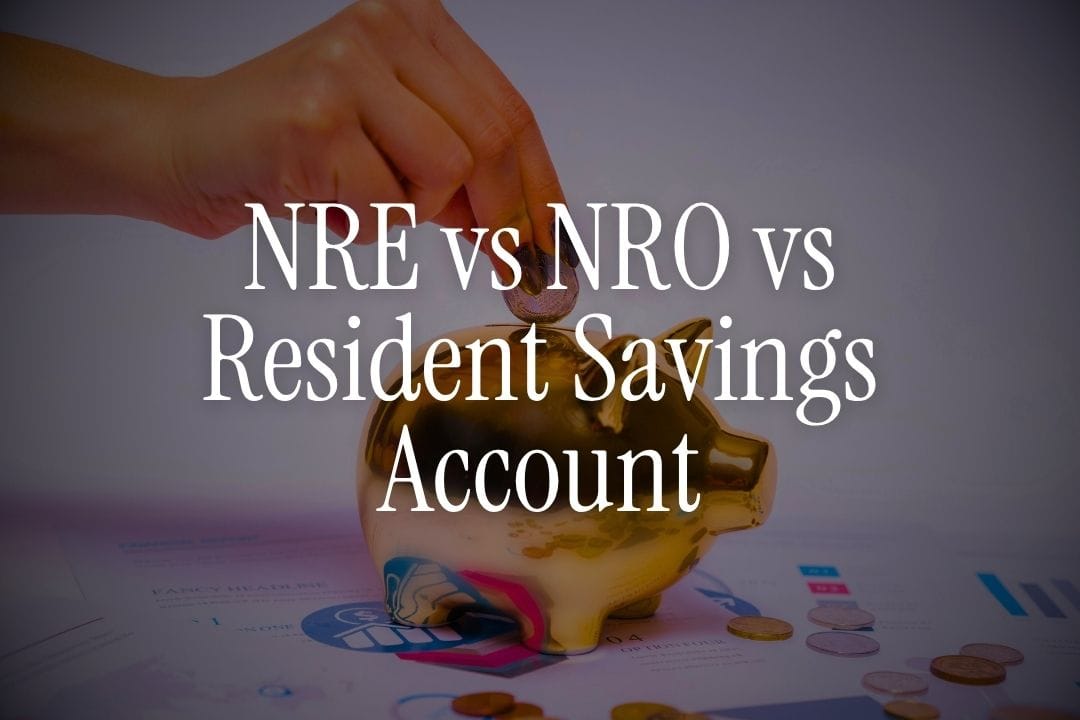
Last week, one of our WhatsApp community members from Dubai asked: "I just moved here three months ago. My salary comes from my UAE company, but I still have rental income from my Mumbai flat. Do I need different accounts for each?"
The answer is yes. And she's not alone in this confusion.
Most NRIs maintain the wrong accounts for years, either overpaying tax or facing compliance issues when they try to repatriate funds.
We've spent 12+ years helping global Indians navigate India's banking system, and we've seen every mistake in the book.
This guide explains the three main account types you'll encounter as an NRI: Resident Savings Accounts (what you had before moving), NRE Accounts (for foreign income), and NRO Accounts (for Indian income).
We'll show you what each does, when to use them, how to convert between them, and why thousands of NRIs are now choosing GIFT City USD deposits as a smarter alternative.
By the end of this article, you'll know exactly which account suits your situation.
What Is a Resident Savings Account?
A resident savings account is what every Indian has before moving abroad. It's the standard SBI, HDFC, or ICICI account you opened while living in India.
Key features include:
- Held in Indian Rupees (INR)
- Interest rate: 2.5% to 4% (depending on balance)
- Interest is taxable as per your income tax slab
- No restrictions on withdrawals or deposits
- Can be used for domestic transactions freely
When Does It Stop Being Valid?
As per FEMA (Foreign Exchange Management Act) rules, you become an NRI if you've been residing overseas (except Nepal or Bhutan) for more than 182 days in one financial year, or if you've moved abroad for employment, business, education, or an uncertain period.
Once you qualify as an NRI, you cannot continue using your resident savings account. You must either close it or convert it to an NRO account.
If you fail to convert your resident account after becoming an NRI, banks can freeze your account and you may face penalties.
👉 Tip: Don't wait for your bank to notice. As soon as you know you'll be abroad for more than six months, start the conversion process.
What Is an NRE (Non-Resident External) Account?
An NRE Account allows NRIs to deposit foreign earnings in India, with balances fully repatriable and tax-free in India. The balances are held in Indian Rupees.
Think of it as your "foreign salary parking account."
Key Features of NRE Accounts
Currency: You deposit in foreign currency (USD, AED, GBP, etc.), which gets converted to INR at prevailing exchange rates. When you withdraw or repatriate, it converts back to foreign currency.
Tax Treatment: Interest earned on NRE accounts is completely tax-free in India. You don't pay a single rupee in tax on the interest. However, you may need to declare it in your country of residence based on their tax laws.
Also Read -DTAA for NRI Bank Interest: Can You Avoid 30% TDS Legally
Repatriation: NRE accounts allow unlimited repatriation of both principal and interest. You can send money back to the UAE, US, UK, or wherever you live without limits or documentation.
Also Read -How to Repatriate Funds from NRO/NRE Accounts
Interest Rates: Most banks offer 2.5% to 3.5% on NRE savings accounts. Fixed deposits can earn 6% to 7.5%, depending on tenure.
Joint Account: NRE accounts can only be held jointly with another NRI. You cannot add a resident Indian as a joint holder.
Also Read -Can NRIs Open Joint Accounts with Residents in India
Who Should Open an NRE Account?
You should open an NRE account if:
- Your primary income comes from abroad (salary, business income, pension from foreign employer)
- You want to save foreign earnings in India
- You plan to repatriate funds freely without worrying about limits
- You want tax-free interest in India
👉 Tip: If you're earning a salary in AED or USD and want to save part of it in India, NRE is your go-to account. The tax-free interest is a significant advantage.
What Is an NRO (Non-Resident Ordinary) Account?
An NRO Account is used by NRIs to manage income earned in India, such as rent, dividends, or pension.
Think of it as your "Indian income collection account."
Key Features of NRO Accounts
Currency: Deposits and withdrawals are in Indian Rupees (INR) only. You can deposit both foreign currency (which will be converted to INR) and INR earned in India.
Tax Treatment: Interest earned on NRO accounts is taxable at 30% plus applicable surcharge and cess. TDS (Tax Deducted at Source) is deducted upfront by the bank.
However, if India has a Double Taxation Avoidance Agreement (DTAA) with your country of residence, you can claim a lower TDS rate by submitting a Tax Residency Certificate (TRC), Form 10F, and a declaration stating you have no Permanent Establishment in India. Read our guide on claiming DTAA benefits.
Repatriation: Repatriation from NRO accounts for current income (such as interest, rent, dividends) is unlimited and freely allowed after paying taxes.
For principal amounts and capital transactions (such as sale proceeds or inheritance), it is limited to $1 million per financial year. (source)
and you'll need to submit documentation like Form 15CA/15CB and a CA certificate.
Interest Rates: NRO savings accounts offer 2.5% to 3.5%. NRO fixed deposits can earn 6% to 7%.
Joint Account: NRO accounts can be held jointly with another NRI or with a resident Indian who is a close relative. This makes them useful for managing family expenses in India.
Who Should Open an NRO Account?
You should open an NRO account if:
- You earn income in India (rent from property, dividends, interest, pension)
- You own assets in India that generate income
- You want to manage expenses in India (paying property tax, utility bills, family support)
- You need a joint account with a resident relative
When you convert your resident savings account after becoming an NRI, it typically becomes an NRO account, not an NRE account.
👉 Tip: If you own rental property in India, an NRO account is mandatory. Your tenants can transfer rent directly to this account, and you can use it to pay property maintenance and taxes.
Also Read -Best NRO Account
NRE vs NRO vs Resident Account: Side-by-Side Comparison
Here's a quick comparison table to see the differences at a glance:
Feature | Resident Savings Account | NRE Account | NRO Account |
|---|---|---|---|
Who can hold it? | Resident Indians only | NRIs, PIOs, OCIs | NRIs, PIOs, OCIs |
Allowed funds | Any INR income | Foreign income only | Indian income + foreign funds |
Currency | INR only | Foreign currency deposited, held in INR | INR only (foreign currency converted) |
Interest rate (savings) | 2.5% - 4% | 2.5% - 3.5% | 2.5% - 3.5% |
Interest rate (FD) | 5% - 7% | 6% - 7.5% | 6% - 7% |
Tax on interest | As per income tax slab | Tax-free in India | 30% TDS (lower with DTAA) |
Repatriation | Not applicable | Unlimited | Up to $1 million/year |
Joint account with resident | Yes | No | Yes (close relatives only) |
Currency risk | No | Yes (INR depreciation) | No (if income is in INR) |
Can continue after NRI status? | No – must convert or close | Yes | Yes |
Sources: RBI FEMA Guidelines, ICICI Bank, HDFC Bank
Also Read -NRE vs NRO vs FCNR
Converting Your Resident Account to NRO: Step-by-Step Process
Once your residential status changes to NRI, it is mandatory to either close your resident savings/current account or convert it to an NRO account. Your fixed and recurring deposits must also be converted to NRO deposits.
When to Convert
You should convert your account as soon as you meet the NRI criteria. Don't wait for the bank to flag it. Banks can freeze accounts if they discover you're an NRI still using a resident account.
Use our free Residential Status Calculator to confirm your status.
Documents Required for Conversion
Most banks require:
- Application form for converting resident account to NRO
- Identity proof (Passport, Aadhaar, Driving License, Voter ID)
- Address proof (same as identity proof options)
- FATCA declaration (for US) or CRS declaration (for UK, Canada, UAE, and 100+ countries)
- PAN card or Form 60
- Copy of employment visa or proof of residence abroad
The Conversion Process
- Visit your bank's NRI section (most banks allow online conversion now)
- Fill the conversion form with your updated residential status
- Upload supporting documents showing you're an NRI
- Submit the application – banks typically process it within 7-10 working days
- Update nomination and FATCA/CRS details if required
After conversion, all your existing funds remain in the NRO account. All your Indian income can continue to be credited to this account.
Your existing debit card and cheque book will continue to work, though some banks issue new ones with "NRO" labeling.
👉 Tip: If you have multiple resident accounts across different banks, you must convert or close each one individually. Start with your primary account and work through the others systematically.
Can You Have Both NRE and NRO Accounts?
Yes, NRIs can have both NRE and NRO accounts simultaneously. These accounts serve different purposes.
In fact, most financially savvy NRIs maintain both:
- NRE Account: For parking foreign salary and savings
- NRO Account: For collecting Indian rental income, dividends, or managing family expenses
You can transfer funds between NRE and NRO accounts, but remember:
- Transferring from NRO to NRE is restricted because NRE accounts can only hold foreign-source funds
- Transferring from NRE to NRO is allowed freely
Understanding Currency Risk: A Hidden Cost
With NRE accounts, currency fluctuations make you prone to exchange rate risk. Here's what that means in practice:
Example: Let's say you're an NRI in Dubai. You deposit $10,000 into your NRE account when 1 USD = ₹82. Your account now has ₹8,20,000.
Three years later, when you want to repatriate, 1 USD = ₹85. Your ₹8,20,000 now converts to only $9,647 — you've lost $353 just to currency depreciation, even though your INR balance stayed the same.
This is why many NRIs are moving to GIFT City USD fixed deposits, where you deposit and earn in USD directly, avoiding INR exposure completely.
👉 Tip: Track the rupee's performance using our Rupee vs Dollar Tracker. If the rupee is weakening (moving from ₹82 to ₹85 per dollar), holding USD is better than holding INR.
Tax Implications: What You Actually Pay
NRE Account Taxation
Interest earned on NRE accounts is completely tax-free in India. You don't file this interest in your Indian tax return.
However, you may need to declare it in your country of residence based on their tax laws. For example:
- UAE: No personal income tax, so NRE interest remains completely tax-free
- USA: You must report worldwide income, including NRE interest, to the IRS
- UK: You may need to declare it if you're a UK tax resident
Check our NRI Taxation Guide for country-specific rules.
NRO Account Taxation
TDS is deducted at 30% plus applicable surcharge and cess on interest earned in NRO accounts.
But you can reduce this through DTAA:
For UAE NRIs: India-UAE DTAA allows interest income to be taxed at 12.5% (instead of 30%) if you submit:
- Tax Residency Certificate from UAE Federal Tax Authority
- Form 10F (filed online)
- Declaration that you have no Permanent Establishment in India
Without DTAA relief, 30% is deducted upfront. You can claim a refund when filing your Indian tax return, but that takes 6-12 months.
👉 Tip: Submit your DTAA documents at the start of each financial year. The bank will apply lower TDS rates immediately, saving you the hassle of claiming refunds.
Repatriation Rules: How to Move Money Abroad
From NRE Accounts
NRE accounts allow unlimited, unrestricted repatriation of both principal and interest. You can transfer your full balance to your foreign account anytime without any approval or documentation.
The process is simple:
- Log into net banking
- Select "International Fund Transfer" or "SWIFT Transfer"
- Enter your foreign bank details
- Submit – funds usually arrive in 1-3 business days
Banks charge transfer fees (typically ₹500-1,500 per transaction plus SWIFT charges).
From NRO Accounts
Repatriation from NRO accounts is capped at $1 million per financial year.
This limit applies to all outward remittances from all your NRO accounts combined, and requires necessary tax documentation.
Documents needed for NRO repatriation:
- Form 15CA (filed online on income tax portal)
- Form 15CB (CA-certified certificate, if applicable)
- Certificate from a Chartered Accountant stating that the remittance doesn't attract tax or that tax has been paid
- Copy of your tax return
Repatriation of principal is capped at $1 million per financial year, subject to documentation.
The $1 million limit resets every financial year (April to March).
👉 Tip: If you need to repatriate more than $1 million in a year, plan ahead. You can structure transactions across financial years or use NRE accounts for larger foreign-source funds.
What Happens When You Return to India?
Let's say you've worked in the UAE for 5 years and now plan to move back to India permanently. What happens to your NRI accounts?
Converting NRE/NRO Back to Resident Accounts
When you return to India and become a resident again, your NRE and NRO accounts should be converted to resident accounts.
Here's how it works:
- NRE accounts: Converted to resident savings accounts. Interest earned before conversion remains tax-free, but interest after conversion becomes taxable as per your Indian income tax slab.
- NRO accounts: Can continue as NRO or be converted to resident accounts. If you still have foreign income, you might keep it as NRO.
RNOR Status: A Middle Ground
If you qualify as RNOR (Resident but Not Ordinarily Resident), you get special tax benefits:
- You can continue holding NRE and NRO FDs, and interest on NRE FDs remains tax-free
- Your foreign income isn't taxed in India (if not earned in India or from an Indian business)
Use our Residential Status Calculator to check if you qualify for RNOR status.
Common Mistakes NRIs Make (And How to Avoid Them)
1. Continuing to Use Resident Accounts After Becoming NRI
This violates FEMA regulations and can result in account freezing and penalties. Convert or close your resident account as soon as you know you'll be abroad for more than 182 days.
2. Mixing Income Sources in the Wrong Accounts
Depositing Indian income (rent, dividends) into an NRE account is not allowed. Keep foreign income in NRE and Indian income in NRO.
3. Not Claiming DTAA Benefits on NRO Interest
Without submitting DTAA documents, you lose 17.5% of your interest to unnecessary tax (30% vs 12.5% for UAE NRIs). File the paperwork once a year and save significantly.
4. Forgetting to Update Residential Status
Banks need to know if you've returned to India or changed countries. Keeping outdated information can create compliance issues during audits.
5. Not Planning for Currency Depreciation
Over the past 10 years, the rupee has depreciated from ₹60 to ₹84 per dollar — a 40% decline. If you're holding large INR balances in NRE/NRO accounts, you're losing purchasing power.
Check our INR vs USD Guide to understand currency trends.
A Smarter Alternative: GIFT City USD Fixed Deposits
While NRE and NRO accounts have served NRIs for decades, they come with limitations:
- Currency risk (rupee depreciation eats returns)
- Moderate interest rates (2.5% to 3.5% on savings)
- Complexity (TDS, DTAA paperwork, conversion documentation)
That's why we built Belong around GIFT City.
What Are GIFT City USD Fixed Deposits?
GIFT City USD savings accounts offer interest as high as 6%, matching or exceeding NRO/NRE savings accounts (2.5-3%), and are only slightly below FCNR accounts.
GIFT City fixed deposits offer competitive returns, tax-free interest (no tax in India), and currency flexibility.
Similar to NRE and FCNR accounts, no restrictions or permissions are needed to move money in and out of GIFT City.
Key Benefits:
- No currency risk: Deposit in USD, earn in USD, withdraw in USD
- Tax-free interest: Interest is not taxed in India (may apply in your country of residence)
- Flexible tenures: GIFT City deposits start from as low as 7 days, while FCNR deposits require a minimum 1-year tenure.
- Better premature withdrawal: Unlike FCNR deposits where entire interest is forfeited on premature withdrawal, GIFT City deposits charge a penalty but you get the rest of the interest.
- Full repatriation: No limits, no paperwork
Compare current rates using our NRI FD Rates Comparison Tool.
Who Is GIFT City Right For?
GIFT City USD deposits are ideal if you:
- Want to avoid rupee depreciation risk
- Earn and save in USD/AED/GBP
- Plan to stay abroad long-term
- Want tax-free returns without TDS hassles
- Need flexible tenures and easy withdrawals
Learn more about GIFT City benefits for NRIs.
Choosing the Right Account: A Decision Framework
Use this framework to decide which account you need:
Step 1: Determine Your Income Sources
Question: Where does your money come from?
- Foreign salary/business: NRE Account or GIFT City USD FD
- Indian rental income/dividends: NRO Account
- Both: Maintain both NRE and NRO accounts
Step 2: Consider Your Repatriation Needs
Question: Will you need to transfer money abroad?
- Yes, frequently and unlimited: NRE Account or GIFT City USD FD
- Yes, but less than $1 million/year: NRO Account works
- Rarely or never: NRO Account is sufficient
Also Read -How to Repatriate Funds from an NRI Account to Abroad
Step 3: Evaluate Tax Impact
Question: How much tax are you willing to pay?
- Zero tax on interest: NRE Account or GIFT City USD FD
- Willing to pay tax (30% or lower with DTAA): NRO Account
Step 4: Factor in Currency Risk
Question: Do you want INR exposure or prefer foreign currency?
- Want to hold USD/foreign currency: GIFT City USD FD
- Don't mind INR exposure: NRE or NRO Account
Step 5: Joint Account Needs
Question: Do you need a joint account with a resident relative?
- Yes: NRO Account (only option)
- No: NRE Account or GIFT City USD FD
👉 Tip: Not sure which is best? Join our WhatsApp Community where our financial advisors and fellow NRIs share advice daily. You can also use our Compliance Compass to check what you're missing.
Final Takeaway: Know Your Accounts, Protect Your Money
Here's what you need to remember:
Resident Savings Account: Only for residents. Convert or close it within 182 days of becoming an NRI to avoid penalties.
NRE Account: For foreign income. Tax-free interest, unlimited repatriation, but exposes you to rupee depreciation risk.
NRO Account: For Indian income. Taxable interest (30% TDS or lower with DTAA), $1 million/year repatriation limit, useful for managing family expenses.
GIFT City USD FD: The modern alternative. Tax-free, no currency risk, flexible tenures, competitive rates up to 5-6%.
Most NRIs benefit from having both an NRE and NRO account to manage different income streams. But if you want to simplify your life and protect yourself from currency depreciation, explore GIFT City options.
The choice depends on your income sources, repatriation needs, and long-term plans.
Use our FD Rates Explorer to compare options, and join our WhatsApp Community to discuss your situation with advisors and fellow NRIs.
Ready to explore smarter NRI investment options?
Download the Belong App and see how we're helping thousands of UAE-based Indians invest tax-efficiently in GIFT City.
Sources:
- Reserve Bank of India - FEMA Guidelines
- ICICI Bank - Convert Savings Account to NRO
- HDFC Bank - NRE vs NRO Account
- ClearTax - NRE and NRO Accounts
- Axis Bank - NRE or NRO Account Comparison
- Western Union - NRE vs NRO Accounts
- BankBazaar - NRE vs NRO Comparison
- Zerodha - GIFT City USD Savings Account
- SBNRI - GIFT City FD Comparison
- Belong - GIFT City FD vs FCNR vs NRE vs NRO




